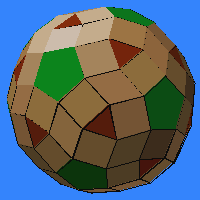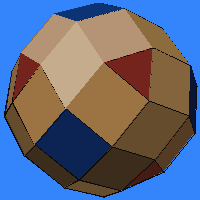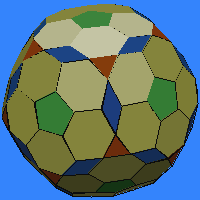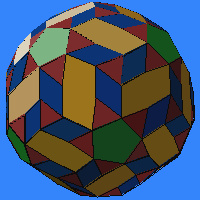Zonish Polyhedra
 This
page contains some of my thoughts in progress on a class of polyhedra which
I do not believe has been examined before. They provide a rich source of
interesting designs and structures, and are relatively easy to construct
or to generate by a simple algorithm. For lack of a better term, my working
name is "zonish" because these have zones, and include zonohedra
as a special case, but generally are not zonohedra. Suggestions for a better
term are most welcome.
This
page contains some of my thoughts in progress on a class of polyhedra which
I do not believe has been examined before. They provide a rich source of
interesting designs and structures, and are relatively easy to construct
or to generate by a simple algorithm. For lack of a better term, my working
name is "zonish" because these have zones, and include zonohedra
as a special case, but generally are not zonohedra. Suggestions for a better
term are most welcome.
Although the zonohedra form a subset of this class of zonish solids, it is a small proper subset. As the figure at right indicates, zonish polyhedra may have faces with an odd number of sides, e.g., triangles and pentagons, which are not possible in zonohedra. This example consists of 122 faces: 12 pentagons, 20 triangles, 60 squares, and 30 golden rhombi (arranged as in the rhombic triacontahedron). As the color indicates, it can be seen as an icosidodecahedron enlarged by the addition of six (tan colored) zones.
The key idea of zonish polyhedra is a generalization of the well known method of constructing a zonohedron in which one zone is added at a time to a smaller zonohedron, starting from a point or a parallelepiped. The only difference is that here we allow any polyhedron to be a "seed" for the process. So a zonish polyhedron is characterized by a convex seed polyhedron (oriented in space) and a set of zonal directions (a "star") which is used to expand the seed. If the seed is a zonohedron, the result is again a zonohedron, but when the seed is chosen not to be a zonohedron, new "zonish" polyhedra are formed. For a symmetric result, the seed and the star directions should be of the same symmetry group.
To illustrate the process, we begin with an icosidodecahedron as seed, and add one zone in a direction parallel to a 5-fold axis. The zonal edge length was chosen to be equal to the seed edge length so the ten new faces are squares rather than rectangles. The result is a Johnson solid, known as elongated pentagonal gyrobirotunda, which is formed by splitting the seed into two hemispheres and inserting edges parallel to the the chosen zonal edge direction. Adding second zone along the direction of a second 5-fold axis gives a result with two zones. Two opposite faces, where the two zones cross, are golden rhombi. The addition of a third zone can be done in two ways. If the three zones all surround some triangle, we get an oblate result. If they have no triangle in common, we get a prolate result. Continuing until zones are constructed for all six axes of 5-fold symmetry gives the six-zone result illustrated above. Note that the final construction depends only on the seed and the set of zonal directions, not the order in which they are used. Also, faces which are not from the seed are always centrally symmetric and part of a zone.
Paper models of the above example are easy to make as there are only four simple types of faces. It can also be quickly approximated with the zometool, since all the edges are in the directions of icosahedral symmetry axes. Not all edges can be equal with the zometool however, as blue and red sticks are required, so the squares must be realized as rectangles.
 As
a second example, analogous but with octahedral symmetry, we can begin
with the cuboctahedron and expand
with four zones in the directions of the axes of 3-fold symmetry. The result
is a pleasing pentacontahedron
consisting of 8 triangles, 30 squares, and 12 square-root-of-two rhombi
(arranged as in the rhombic dodecahedron).
I have noticed that a picture of it appears in two books
of Peter Pearce: Structure in Nature is a Strategy for Design (p.
49) and Polyhedra Primer (p. 50) but not with this method of construction.
(The related pentacontahedron illustrated in those books on the same pages
is the 13-zone zonohedron based
on the symmetry axes of the cube.)
As
a second example, analogous but with octahedral symmetry, we can begin
with the cuboctahedron and expand
with four zones in the directions of the axes of 3-fold symmetry. The result
is a pleasing pentacontahedron
consisting of 8 triangles, 30 squares, and 12 square-root-of-two rhombi
(arranged as in the rhombic dodecahedron).
I have noticed that a picture of it appears in two books
of Peter Pearce: Structure in Nature is a Strategy for Design (p.
49) and Polyhedra Primer (p. 50) but not with this method of construction.
(The related pentacontahedron illustrated in those books on the same pages
is the 13-zone zonohedron based
on the symmetry axes of the cube.)
The above two examples are somewhat special in that they begin with quasi-regular polyhedra and expand in directions orthogonal to their equatorial polygons. As a consequence they are also equivalent to expansions of the seed polyhedron (or their dual rhombic polyhedra) by Mrs. Stott's method of expanding faces. (See W.W. Rouse Ball) If one applies either that method or the zonish expansion (along the three 4-fold axes) to the remaining convex quasiregular polyhedron, the octahedron, the result is the rhombicuboctahedron, yet another zonish polyhedron. However, in most cases, zonish solids and Mrs. Stott's expansions are very different things.
Another similar example, but with only tetrahedral symmetry, uses the tetrahedron as seed and expands in the directions of its four 3-fold axes. The resulting 28-sided solid has 4 triangles, 12 squares, and the same 12 square-root-of-two rhombi. Observe how its faces are a subset of the above pentacontahedron.
Every zonish polyhedron is in a sense intermediate between two related zonohedra, one which it contains and one which contains it:
- The construction and the above examples should make clear that a zonish polyhedron always has a subset of its faces corresponding to the pure zonohedron based on its star, thus ignoring the seed. In the above cases, the subset of faces which are rhombic correspond to the triacontahedron and rhombic dodecahedron respectively. They are determined purely by the star.
- A zonish polyhedron is also related to a larger zonohedron based on the star plus all the edge directions of the seed. For example, the example at the top of this page has all its faces parallel to the 122 faces of the 21-zone zonohedron based on all the 2-fold and 5-fold axes of the icosahedral symmetry group. (This is because the edges of the icosidodecahedron are parallel to its 2-fold axes.)
 Larger
faces may arise in the expansion process when three or more relevant directions
are coplanar. For example, the seed's faces expand when a star direction
is parallel to a seed face. And if two star directions are coplanar with
a seed edge direction, 6-sided faces arise. Here are a few examples, to
illustrate some of the variety possible:
Larger
faces may arise in the expansion process when three or more relevant directions
are coplanar. For example, the seed's faces expand when a star direction
is parallel to a seed face. And if two star directions are coplanar with
a seed edge direction, 6-sided faces arise. Here are a few examples, to
illustrate some of the variety possible:
- icosidodecahedron + 10 directions (axes of 3-fold symmetry) --- illustrated at right, this is a nice project to make with the zometool (only blue and yellow sticks are needed).
- icosahedron + 10 directions (axes of 3-fold symmetry) --- another good zometool project (blue and yellow sticks)
- dodecahedron + 10 directions (axes of 3-fold symmetry) --- (blue and yellow sticks)
- dodecahedron + 6 directions (axes of 5-fold symmetry) --- Equivalent to truncating the rhombic triacontahedron at its 5-fold vertices. Don't confuse this with the truncated icosahedron; note that the 30 hexagons (not 20) lie in equatorial zones, they each touch two (not three) pentagons, and they are slightly irregular.
- snub dodecahedron + 6 directions (axes of 5-fold symmetry) --- as illustrated below, this shows that zonish polyhedra may be chiral (unlike zonohedra) if the seed is chiral. The faces of the seed snub dodecahedron are not all separated by the six zones.
- triakis octahedron + 12 zones --- the star here is based on the face normals, not the axes of symmetry of the seed triakis octahedron, but again has octahedral symmetry.
- decagonal prism + 10 --- this illustrates a nice rosette effect which can result when the seed has prism symmetry. The star is based on the vertices of the seed decagonal prism.
 Akin
to zonohedra, the zonal expansion construction illustrates how zonish polyhedra
can be nicely dissected. While a zonohedron
can be dissected entirely into parallelepipeds, the analogous construction
dissects a zonish polyhedron into parallelepipeds, prisms (based on the
seed's faces) and one copy of the seed itself. This suggests some interesting
puzzle toys.
Akin
to zonohedra, the zonal expansion construction illustrates how zonish polyhedra
can be nicely dissected. While a zonohedron
can be dissected entirely into parallelepipeds, the analogous construction
dissects a zonish polyhedron into parallelepipeds, prisms (based on the
seed's faces) and one copy of the seed itself. This suggests some interesting
puzzle toys.
Just as an n-zone zonohedron is the convex hull of the projection of
an n-dimensional hypercube into 3-space, so a zonish polyhedron with n
zones is the projection of a n+3 dimensional object --- the cross of the
seed and an n-dimensional hypercube --- into 3-space. And incidentally,
the process can be applied to higher-dimensional seed polytopes as well.
If someone writes a 4D viewer Netscape plug-in, I'll make some zonish data
files for it.